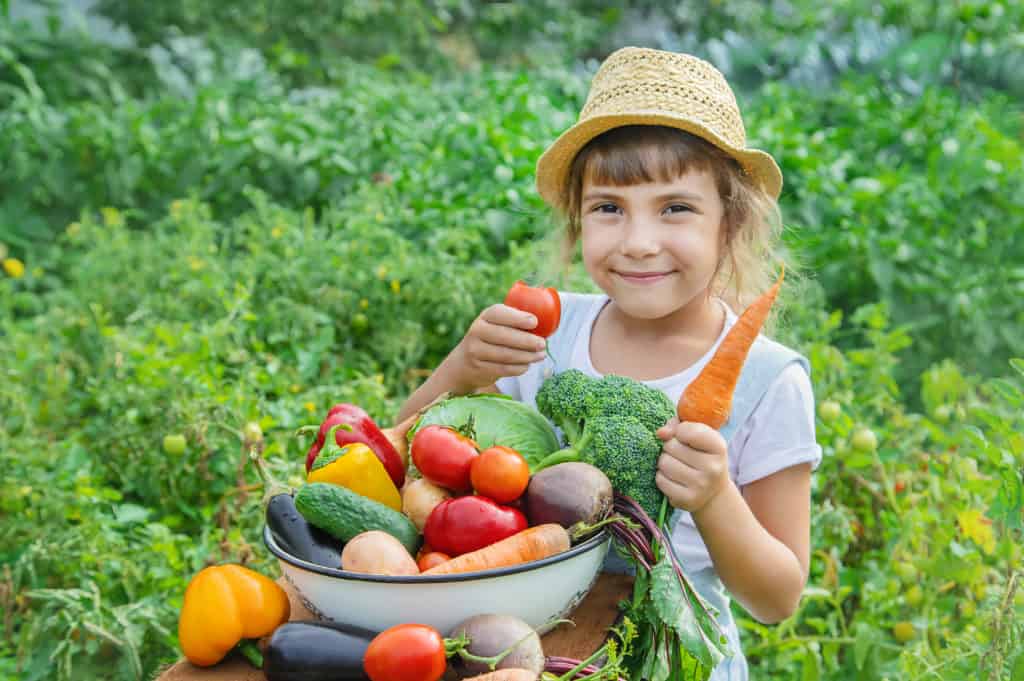
It probably comes as no surprise that children don’t even come close to eating the recommended amounts of vegetables (actually, neither do the vast majority of adults, but that’s a post for another time). Maybe you have an anti-veggie kid living with you right now and know first-hand that getting vegetables off the plate and into the child can be a daunting task. But take heart, parents! With your help, your child can learn to enjoy at least a few different vegetables—do not give up!
Veggie Nutrition
Nutritionally, vegetables are packed with a wide variety of vitamins and minerals, fiber and beneficial plant compounds (some of which we know about, and others yet to be discovered) that help young bodies develop and grow. But beyond the immediate nutritional value vegetables provide, building a liking for veggies and a habit for eating them sets kids up for a lifetime of health benefits.
One thing you might not realize is that vegetables in all forms can be nutritious—fresh, frozen, or canned versions all have their strong points. Comparing products using Guiding Stars makes it easy to see which veggies in which forms offer the most nutritional value (go for those 3-star veggies most often). So if your child has a penchant for peas from a can but doesn’t like the frozen ones, that’s not a problem, just opt for the lowest added-salt canned peas you can find.
Is there a scientific reason why kids may not like veggies?
The liking for sweet tastes is inborn in humans, and research shows that children naturally prefer higher levels of sweetness than adults do. What’s more, although there is, of course, genetic variation in everyone’s perception of bitter taste, in general, children are more bitter sensitive than adults. Being anti-bitter as a child is protective for them, Mother Nature wants to protect our wee ones from ingesting dangerous or even poisonous substances, which often contain bitter-tasting compounds. Given this, it’s no wonder that bitter veggies like Brussels sprouts or broccoli raab aren’t typically on childrens’ “favorite foods” lists. Luckily, bitter tastes become better tolerated by the mid-teen years.
Accept that some veggies just aren’t going to be favorites.
Believe me, I knew I had it easy when my kiddos were young—most of their friends were not nearly as veggie-loving as mine (and I bet I’m safe to say that none of them counted artichokes in their top 3 favorite foods the way my son did in grade school). Mine both loved salads and typical salad veggies (a good thing since we ate them nearly every night), readily ate broccoli and cauliflower, and even enjoyed some more unusual things like jicama.
Still, no matter how many times they tried sweet potatoes or yams (even when gussied up with brown sugar), they just didn’t learn to like them. Beets were a hard sell back then, and they still are. (That’s okay, more for me!) Last month I learned that my college-aged daughter now likes mushrooms, even though as a child she could detect the tiniest bits of chopped mushrooms in various dishes—a just cause for complete rejection in her book. Just like adults, kids will have their preferences and may never learn to like a wide range of vegetables. However, don’t let that deter you from trying to expand their veggie horizons! Even increasing a child’s acceptance of a few more vegetables can make a nutritional and health difference.
Ideas to boost your child’s veggie intake:
Serve vegetables first.
Research indicates serving vegetables to your child prior to the meal, say, while you are preparing dinner, can help increase your child’s intake, according to a 2019 study. Offering a nice plate of vegetables (with some sort of dip, if you child likes it) before other foods are offered takes advantage of your child’s high level of pre-meal hunger.
Offer two veggies at a meal.
Who doesn’t like having choices? Everyone likes choices, including kids. Letting your child serve himself or herself from a couple of options increases the chance that at least some of it will end up being consumed. Consider offering one cold veggie and one hot/cooked veggie option. You don’t have to cook up anything fancy or time-consuming, just having more than one option to choose from is the goal. Don’t be discouraged if your child doesn’t like cooked carrots, they might like them raw. You can also modify the way the veggies are presented—try shredded carrots or zucchini spirals—your tyke might be more tempted to try them.
Let your child get “artsy” with their veggies.
Most parents have already heard that letting kids be involved in cooking food can increase the likelihood that the child will eat the food he or she cooked. Taking this idea a step further, researchers allowed kids to create an “artistic plate” with a variety of vegetables (including some novel ones and some that were familiar to the kids) or just sample the veggies used. Both groups of children were more willing to taste new veggies, but those who crafted their own veggie plates had higher levels of positive feelings after the activity. The researchers surmise that self-crafting creates positive feelings with unfamiliar foods.
Nix the health messages when serving veggies.
Emphasize taste instead. Hearing that vegetables can help them grow strong, see better, run faster, etc. is not a particularly effective strategy for making kids want to eat them, says a study of 270 youngsters aged 3-5. In the study, the children ate more of a food when it was presented with no commentary at all, or when it was just described as tasting good, vs when it was accompanied by a health-related message.
“Augment” the veggie content of their favorite foods.
This is one of those “steal health” strategies that won’t always work, but won’t harm, either. Generally I’m not one to advocate this kind of technique, but instead of thinking of it as “sneaking” veggies into your child’s mac-and-cheese, maybe view it as simply augmenting the nutritional value of the dish. I wrote about this topic on the Guiding Stars blog before, and included some easy and practical ideas you can try.
Eat more vegetables yourself!
Modeling the behavior you want you children to have—at least with regard to what we are eating—is an excellent way to encourage your child to eat veggies (and it’s also helpful for making sure that you get enough veggies, too). If eating vegetables is not just something you seem to just force on them (they’ll notice), but instead is something that they grow up seeing their care-givers do every day, it’s less likely to be a big deal. In other words, they’ll get in the habit of it.
Rainbow Pizza
Give your kids appealing, colorful options, and don't stress too much if they aren't eager to eat every option.
View recipe »